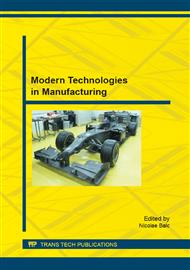[1]
J. Komson, K. Choobunyen, Effect of Turning Parameters on Roundness and Hardness of Stainless Steel: SUS 303, AASRI Conference on Modelling, Identification and Control, AASRI Procedia 3 (2012) 160 – 165.
DOI: 10.1016/j.aasri.2012.11.027
Google Scholar
[2]
A Carean, N. Balc, R. Curta, Researches on machining of complex parts on CNC turning centres with milling capabilities, Academic Journal of Manufacturing Engineering, VOL. 7, Issue 3/2009, pp.78-83, ISSN: 1583-7904.
Google Scholar
[3]
J. Paulo Davim, V.N. Gaitonde, S.R. Karnik, Investigations into the effect of cutting conditions on surface roughness in turning of free machining steel by ANN models, Journal of materials processing technology 205 (2008) 16–23.
DOI: 10.1016/j.jmatprotec.2007.11.082
Google Scholar
[4]
J. Valíček, M. Harničárová, J. Müllerová, M. Kušnerová, Analogy between flexible abrasive waterjet technology and traditional chip - Machining technology, Materialwissenschaft und Werkstofftechnik Volume 46, Issue 4-5, 1 May 2015, pp.401-413.
DOI: 10.1002/mawe.201500415
Google Scholar
[5]
N.S. Reddy, P.V. Rao, Selection of optimum tool geometry and cutting conditions using a surface roughness prediction model for end milling, 2005, Int. J. Adv. Manuf. Technol. 26, 1202–1210.
DOI: 10.1007/s00170-004-2110-y
Google Scholar
[6]
I. Kuric, M. Košinár, M. Cisár, Measurement and analysis of CNC machine tool accuracy in different location on work table, Proceedings in Manufacturing Systems, Volume 7, Issue 4, (2012).
Google Scholar
[7]
J. Jerzy, I. Kuric, S. Grozav, V. Ceclan, Diagnostics of CNC machine tool with R-Test system, Academic Journal of Manufacturing Engineering, Vol. 12, Issue 1/2014, ISSN: 1583-7904, pp.56-60, Editura Politehnica.
Google Scholar
[8]
Information on http: /www. modernapplicationsnews. com/articles/m0702steel. htm.
Google Scholar
[9]
A.B. Junior, A.E. Diniz, F.T. Filho, Tool wear and tool life in end milling of 15-5 PH stainless steel under different cooling and lubrication conditions, The International Journal of Advanced Manufacturing Technology, 2009, 43: 756–64.
DOI: 10.1007/s00170-008-1744-6
Google Scholar
[10]
P. Atul, G. Girish, Dry turning of AISI 304 austenitic stainless steel using AlTiCrN coated insert produced by HPPMS technique, International Conference in Design and Manufacturing, (2013).
DOI: 10.1016/j.proeng.2013.09.149
Google Scholar
[11]
G. Królczyk, M. Gajek, S. Legutko, Effect of the cutting parameters impact on tool life in duplex stainless steel turning process, Tehnicki Vjesnik-Technical Gazette 20 (4), 587-592.
Google Scholar
[12]
G. Krolczyk, P. Nieslony, and S. Legutko, Micro-hardness and Surface Integrity in Turning Process of Duplex Stainless Steel (DSS) for Different Cutting Conditions Journal of Materials Engineering and Performance March, Volume 23, Issue 3, pp.859-866 (2014).
DOI: 10.1007/s11665-013-0832-4
Google Scholar
[13]
N. Lungu, M. Borzan, Effect of cutting speed and feed rate on tool geometry, temperature and cutting forces in machining AISI 1045 carbon steel using FEM simulation, Proceedings in Manufacturing Systems 7 (4), 245-252.
DOI: 10.4028/www.scientific.net/amm.436.194
Google Scholar
[14]
Information on http: /www. mitsubishicarbide. com.
Google Scholar
[15]
L. Morovič, P. Pokorný, Optical 3D Scanning of Small Parts, Advanced Materials Research, Vol. 468-471, pp.2269-2273, February, (2012).
DOI: 10.4028/www.scientific.net/amr.468-471.2269
Google Scholar
[16]
A. Popescu, H. Iancau, P. Bere, M. Simon, Experimental and theoretic research regarding optimization extrusion process for polymers reinforced fiber (PA 6. 6 – 30 % gf), Acta Technica Napocensis-series: Applied Mathematics, Mechanics and Engineering, (2013).
DOI: 10.4028/www.scientific.net/amm.808.125
Google Scholar


